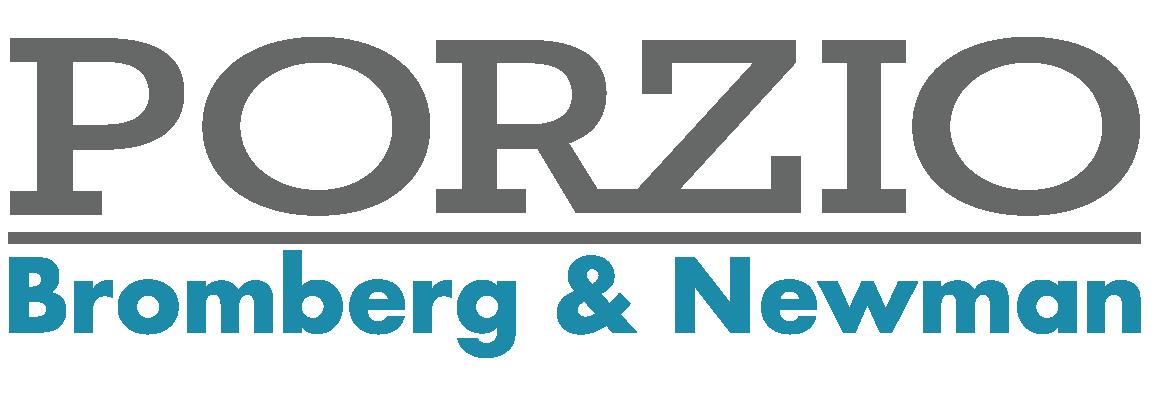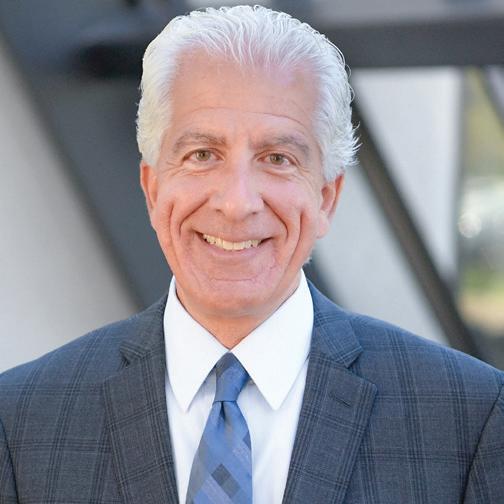Law


2022 - Year in Review Employment
Porzio’s Employment Law 2022 Year in Review contains an extensive compilation of articles on workplace policies, independent contractors, wage and hour, discrimination, employment agreements, cannabis, and best practices. We recommend employers review their policies to ensure compliance with all federal, state, and local laws. If you have any questions or if we can otherwise help in any way, please feel free to reach out to a member of the Employment Law Team. Employers also may wish follow us at @PorzioLaw for the latest updates and changes in the law.
Kerri A. Wright Editor-In-Chief (973) 889-4327 KAWright@pbnlaw.com

TABLE OF
Independent Contractors
New Rule Proposed by the Department of Labor on Classifying Independent Contractors
Workplace Policies
Where is Boeing Going? (All Employers Should Pay Close Attention to Potential Changes in The Standards for Employer Policies or Practices That May Limit Concerted Activity)
New Jersey Prohibits Employers From Tracking Employees’ Vehicles Without Warning
OSHA’s Emergency Temporary Standard Goes Into Effect January 10, 2022
The Supreme Court Has Blocked Vaccine and Testing Mandate for Large Businesses but Allows Health Care Worker Vaccine Mandate
Cannabis
Cannabis Regulatory Commission Issues Interim Guidance On Workplace Impairment
Where There’s Smoke, “You’re Fired”? How the Sale of Personal Use Cannabis in New Jersey Ignites Tensions With Employers’ Drug-Free Workplaces
Wage and Hour
Title & Pay Are Not Enough to Guarantee Exempt Status 17
Nondisclosure vs. Non-disparagement: The Current Loophole in EmployerEmployee Settlement Agreements Arising Under the Law Against Discrimination
The New Jersey Legislature Tried to Carve Out NJLAD Claims From Mandatory Employment Arbitration Agreements: State Courts Said “Not so Fast”
Employment Discrimination
Employers Must Recognize and Support Male Victims of Sexual Harassment in The Workplace
Employer Best Practices
New Guidance For Businesses When Responding to A Subpoena
Cybersecurity Risks: New Developments Regarding Employer Liability for Work-Related Identity Theft

Contents
04
06
08
10
12
13
15
18
Employment Agreements 20
22
26
Employment Law Team About Us 24
25
New Rule Proposed by the Department of Labor On Classifying Independent Contractors
Porzio Employment Law Monthly – October 2022
By Kerri A. Wright and David L. Disler
In a constantly evolving economy, New Jersey and the Federal government have taken strong positions regarding the use of independent contractors. For example, in a “record-setting case for New Jersey,” Uber paid the State of New Jersey $100 million after the New Jersey Department of Labor and Workforce Development found that the company misclassified as independent contractors nearly 300,000 drivers in New Jersey who should have been classified as employees.1 As the New Jersey Attorney General made clear, New Jersey “will not tolerate companies that misclassify their workers, thereby denying employees vital benefits and dodging their obligation to contribute to programs that benefit the workforce. By misclassifying workers, companies both harm their employees and sidestep their obligations under the law. New Jersey will continue to enforce our employee misclassification laws aggressively to prevent such conduct. As the economy changes, we will vigorously defend workers’ rights.”2 In a press release following the Uber payment, the New Jersey Department of Labor and Workforce Development made clear that its continuous enforcement on the classification of workers will be “rigorous.” 3
The United States Department of Labor likewise closely scrutinizes the classification of independent contractors. Under the Fair Labor Standards Act (FLSA), employers must meet the law’s minimum wage, overtime, and recordkeeping requirements as it relates to their employees (which does not apply to independent contractors). The Biden Administration has taken a strong position on this issue, repealing the rule issued during the Trump Administration in January 2021 that narrowed the scope of workers classified as employees as
compared to independent contractors (see our alert issued in January 2021 describing the former rules) The previous rule created a simplified test that stressed only two core factors to determine when an employee was an independent contractor: (1) a worker’s control over their work; and (2) their opportunity for profit or loss.
Under the Biden Administration’s proposed rule, far more workers would be classified as employees, rather than independent contractors. Under the proposed rule, an employee would be defined more broadly, to encompass all workers who “as a matter of economic reality, are economically dependent on an employer for work.” Comparatively, independent contractors are limited to workers who, as a matter of economic reality, are “in business for themselves.” The proposed rules provide a six-factor test to determine whether an employee is economically dependent on the employer:
1. Opportunity for profit or loss depending on managerial skill.
This factor examines whether the individual can earn profits or incur losses based on his or her exercise of initiative (such as managerial skill or business acumen or judgment) or management of his or her investment in or capital expenditure.
The Department of Labor provides the following example: a worker for a landscaping company performs assignments only as determined by the company for its corporate clients. The worker does not independently choose assignments, solicit additional work from other clients, advertise their services, or endeavor to reduce costs. The worker regularly agrees to work additional hours to earn more. In this scenario, the worker does not exercise managerial skill that affects their profit or loss. Rather, their earnings may fluctuate based on the work available and their willingness to work more. Because
of this lack of managerial skill affecting opportunity for profit or loss, this factor indicates employee status.
2. Investment by the worker and the employer.
This factor examines whether there are any investments made by the worker and whether those investments are capital or entrepreneurial. Such investments, for example, generally support an independent business and serve a business-like function, such as increasing the worker’s ability to do different types of or more work, reducing costs, or extending market reach, thus suggesting that the worker is in business for themself.
The Department of Labor provides the following example: a graphic designer provides design services for a commercial design firm. The firm provides software, a computer, office space, and all the equipment and supplies for the worker. The company invests in marketing and finding clients and maintains a central office from which to manage services. The worker occasionally uses their own preferred drafting tools for certain jobs. In this scenario, the worker’s relatively minor investment in supplies is not capital in nature and does little to further a business beyond completing certain jobs. Thus, this factor indicates employee status.
3. Degree of permanence of the work relationship.
This factor examines whether the work relationship is “by design indefinite in nature or continuous,” which would favor the worker being an employee, rather than an independent contractor.
1Price Mueller, Karin, Uber Pays a Record $100M in Back Taxes to N.J. for Treating Drivers as Gig Workers, available at https://www.nj.com/news/2022/09/ uber-pays-a-record-100m-in-back-taxes-to-nj-for-treating-drivers-as-gig-workers.html#:~:text=In%20a%20record%2Dsetting%20case,a%20 misclassification%20case%2C%20it%20said
2New Jersey, Department of Labor & Workforce Development, Uber Pays $100M in Driver Misclassification Case with NJ Department of Labor and Workforce Development and Attorney General’s Office, available at nj.gov/labor/lwdhome/press/2022/20220913_misclassification.shtml 3Id.
2022 - A Year in Review 4
The Department of Labor provides the following example: a cook has prepared meals for an entertainment venue continuously for several years. The cook prepares meals as directed by the venue, depending on the size and specifics of the event. The cook only prepares food for the entertainment venue, which has regularly scheduled events each week. The relationship between the cook and the venue is characterized by a high degree of permanence and exclusivity. The permanence factor indicates employee status.
4. Nature and degree of control.
This factor examines the control the company has over the key aspects of the performance of the work. Such factors include setting schedules, compelling attendance, supervising or directing the work, selecting projects, setting prices for services, controlling workloads, and affecting the worker’s ability to work for others. However, the “analysis focuses on whether the employer still retains control over meaningful economic aspects of the work relationship such that the control indicates that the worker does not stand apart as their own business, not simply whether the employer lacks control over discrete working conditions (e.g., scheduling) or whether the employer failed to exercise physical control over the workplace.”
The Department of Labor provides the following example: a registered nurse provides nursing care for Alpha House, a nursing home. The nursing home sets the work schedule with input from staff regarding their preferences and determines where in the nursing home each nurse will work. Alpha House’s internal policies prohibit nurses from working for other nursing homes while
employed with Alpha House to protect its residents. In addition, the nursing staff are supervised by regular check-ins with managers, but nurses generally perform their work without direct supervision. While nurses at Alpha House work without close supervision and can express preferences for their schedule, Alpha House maintains control over when and where a nurse can work and whether a nurse can work for another nursing home. These facts related to the control factor indicate employee status.
5. Whether work performed is an “integral” part of the employer’s business.
This factor examines whether the type of work being performed by the worker is central to the employer’s business, i.e. whether the work is “critical, necessary, or central to the employer’s business.”
The Department of Labor provides the following example: a large farm grows tomatoes it sells to distributors. The farm pays workers to pick the tomatoes during the harvest season. Because picking tomatoes is an integral part of farming tomatoes, and the company is in the business of farming tomatoes, the tomato pickers are integral to the company’s business. The integral factor indicates employee status.
6. Skill and initiative.
This factor examines whether a worker uses specialized skills to perform the work and whether those skills contribute to business-like initiative consistent with the worker being in business for themself instead of depending economically on the employer.
The Department of Labor provides the following example: a highly skilled
welder provides welding services for a construction firm. The welder does not make any independent judgments at the job site beyond the decisions necessary to do the work assigned. The welder does not determine the sequence of work, order additional materials, think about bidding the next job, or use those skills to obtain additional jobs, and is told what work to perform and where to do it. In this scenario, the welder, although highly skilled technically, is not using those skills in a manner that evidences business-like initiative. The skill and initiative factor indicates employee status.
The proposed rule notes that additional factors may be considered if they are relevant to the ultimate question of whether workers are economically depending on the employer for work or in business for themselves. The proposed rule provides that the “totality of the circumstances” must be evaluated to determine the worker’s status as employee or independent contractor.
The proposed rule is now subject to public comment over a 45-day period, which the Department will review and consider before finalizing the new rule.
Recommended Actions for Employers
Based on the proposed Federal rule and the positions taken by New Jersey and the Federal governments on the classification of independent contractors, employers must be cautious when classifying workers as independent contractors. The New Jersey Governor’s Office and the Biden Administration have made it clear they will closely examine employment classifications to ensure employees are properly categorized. Those employers inappropriately classifying employees as independent contractors will face harsh penalties.
Employers and HR professionals should review their classifications of workers as independent contractors under the applicable legal standards to ensure they have supporting documentation for their decisions to classify a worker as an independent contractor. Employers using staffing agencies also should review their contracts with the agencies to ensure the contracts shield them from liability in the event of a wage and hour or other employment-related violation.
5 pbnlaw.com
Porzio Employment Law Monthly – March 2022
Many employers tend to think only of traditional labor and unionized workforces at the mention of the National Labor Relations Act. However, the NLRA’s protection, at Section 7, of the right to engage in “other concerted activities for the purpose of . . . mutual aid or protection”4 extends to nearly all employees, regardless of whether such activity is undertaken in the context of traditional organizing or collective bargaining. Accordingly, nearly all employers may be impacted by shifts in the standard for determining when a policy or practice unlawfully restricts activity protected by Section 7. This standard has been expanding and contracting for decades, and expansion is on the horizon again as President Biden’s Democratcontrolled board recently invited party briefs and amici in the Stericycle, Inc. matter, soliciting input on whether the standard established by the National Labor Relations Board in 2017 in the matter of Boeing Co.5 sufficiently protects employees.6
Turbulence from Martin Luther to AT&T Mobility
In 2004, in the matter of Martin Luther Memorial Home, Inc., the Board held that an employer policy that does not set forth an express restriction of Section 7 activity may be unlawful nonetheless if “(1) employees would reasonably construe the language to prohibit Section 7 activity; (2) the rule was promulgated in response to union activity; or (3) the rule has been applied to restrict the exercise of Section 7 rights.”7 In that case, the Board upheld rules prohibiting “abusive and profane language,” “harassment,” and “verbal, mental and physical abuse” as complying with the NLRA, but found that rules prohibiting solicitation, loitering, and unlawful strikes, work stoppages, or other interference were unlawful.8
In 2017, however, in deciding the Boeing Co. case, the Trump administration’s Board lamented the way in which the Obamaera Board applied the Martin Luther “reasonably construe” standard, stating that the Board “subsequently lost its way . . . it invalidated commonsense rules and requirements that most people would reasonably expect every employer to maintain[,]” and “viewed challenged rules not from the standpoint of reasonable employees, but from that of traditional labor lawyers who have devoted their professional lives to interpreting and applying the NLRA” thereby outlawing policies and rules that a reasonable employee would expect a reasonable employer to have.9
In Boeing Co., the NLRB evaluated whether a policy restricting the use of camera-enabled devices such as cell phones on company property unlawfully restricted Section 7 rights. The Administrative Law Judge had found that the policy violated the NLRA because a reasonable employee could construe the policy to violate Section 7 rights, but the NLRB reversed the ALJ, adopting a new test setting forth that if a policy is not explicitly unlawful, the Board will evaluate “(1) the rule’s potential impact on protected concerted activity; and (2) the employer’s legitimate business justifications for maintaining the rule.” Tribunals applying the Boeing rule essentially would engage in a balancing test to evaluate whether and to what extent a rule’s potential unlawful impact outweighed its justifications, and also would consider whether the employer had applied the rule to restrict Section 7 rights, leaving intact the “applied to restrict” factor of the Martin Luther test.
Then, in 2021, after President Biden’s inauguration, but before control of the Board flipped to the Democrats, the Board revisited its own precedent to further narrow the rule, divesting the “applied to restrict test” from the inquiry as to lawfulness of a rule itself, and thereby overruling what remained of Martin Luther. In AT&T Mobility, an employer had applied a norecording rule similar to one upheld in Boeing Co. to prohibit an employee from recording what clearly was protected Section 7 activity. Instead of striking down the rule for failing the “applied to restrict” test, the Board held that whether a rule had been applied to restrict Section 7 rights no longer was part of the test, and instead was a violation to be evaluated and addressed separately. As it stands, the test for whether an employer rule or policy unlawfully restricts Section 7 rights is “(1) the rule’s potential impact on protected concerted activity; and (2) the employer’s legitimate business justifications for maintaining the rule” as set forth in Boeing Co., and even a rule or policy that is applied to restrict Section 7 rights may be lawful, as the unlawful application no longer is relevant to the inquiry into the propriety of the rule itself.
4 29 U.S.C. § 157.
5Boeing Co., 365 N.L.R.B. No. 154 (2017).
6Stericycle, Inc., 371 N.L.R.B. No. 48 (January 6, 2022).
7Martin Luther Memorial Home, Inc., 343 N.L.R.B. No. 75 (November 19, 2004).
8Id.
9L.A. Specialty Produce Company, 368 N.L.R.B. No. 93 (October 10, 2019).
Where is Boeing Going?: All Employers Should Pay Close Attention to Potential Changes in the Standards for Employer Policies or Practices That May Limit Concerted Activity
6
Where will the NLRB Land?
In the recent Stericycle, Inc. matter, the Board invited party briefs and amici on four questions: (1) Should the Board continue to adhere to Boeing Co. standard?; (2) How, if at all, should the Board modify existing law on maintaining employer work rules “to better ensure that: (a) the Board interprets work rules in a way that accounts for the economic dependence of employees on their employers and the related potential for a work rule to chill the exercise of Section 7 rights by employees; (b) the Board properly allocates the burden of proof in cases challenging an employer’s maintenance of a work rule under Section 8(a)(1); and (c) the Board appropriately balances employees’ rights under Section 7 and employers’ legitimate business interests?”; and (3) Should the Board continue to hold always lawful certain categories of work rules including investigative confidentiality rules, rules prohibiting outside employment, and non-disparagement10 rules. Briefs were due March 7, 2022 and responsive briefs were due March 22, 2022.
While it is expected that the NLRB will give due consideration to briefs filed, it is also safe to assume, given the composition of the current Board, that any modifications to the Boeing Co. standard will be employeefriendly. A return of the “reasonably construe” test may be in order, and, if the pendulum swings far enough, forthcoming decisions may even require employers to do more affirmatively to enable employees to engage in Section 7 activity, as opposed to simply refraining from restricting it. An example of this approach by the Board under President Obama is set forth in the since-overruled matter of Purple Communications, Inc., where the Board found a presumption “that employees who have rightful access to their employer’s email system in the course of their work have a right to use the email system to engage in Section 7-protected communications on nonworking time,” rebuttable only by a showing of “special circumstances necessary to maintain production or discipline justify restricting its employees’ rights.”11 It remains possible that President Biden’s Board will act similarly, and that the presently austere Boeing Co. test either will undergo a liberal makeover, or will be eschewed entirely in favor of a more indulgent standard for workers.
Unpacking Employer Obligations and Recommendations in the Interim

Until the Board rules, it will not be possible to know for sure which employer policies will remain lawful and which will need to be amended to comply with a new standard. For the time being, employers may wish to review existing policies to evaluate whether such policies might discourage a reasonable employee from discussing the terms and conditions of employment or the work environment with colleagues. If so, a proactive modification might be in order, even if the policy is justified by a legitimate business consideration. In any event, employers should pay close attention to updates from the NLRB in the coming weeks and months. Employers seeking to review existing employee policies or implement new ones should contact legal counsel for guidance.
10Stericycle, Inc., 371 N.L.R.B. No. 48 (January 6, 2022).
11Purple Communications, Inc., 361 N.L.R.B. 1050, 1063 (December 11, 2014).
New Jersey Prohibits Employers from Tracking Employees’ Vehicles Without Warning
Porzio Employment Law Monthly – January 2022
By Kerri A. Wright and David L. Disler
Recent technological advancements have made employer’s ability to monitor and track employees easier and more cost effective than in the past. In response to this trend, recently enacted legislation prohibits employers from using a tracking device in an employee’s or company’s vehicle unless prior written notice is provided to the employee.
The intent behind the new law is to protect workers’ privacy rights. However, the Legislature clearly recognized that employers have a legitimate interest in knowing where their employees are and, under certain circumstances, knowing where they have been. The law provides a compromise between the legitimate interests of both employers and employees. It allows employers to track their employees while, at the same time, allowing employees to make informed decisions based on the notice required by the statute, including whether they want to work for an employer who tracks their whereabouts.
The law applies to all employers operating in the State of New Jersey and their agents or representatives, except the Department of Corrections, State Parole Board, county correctional facilities, State or local law enforcement agencies, or any public transportation system.
The law provides that employers are not permitted knowingly to use a tracking device in a vehicle used by an employee when the device is designed or intended to be used for the sole purpose of tracking the movement of a vehicle, person or device. While the original bill had some ambiguity regarding employers who “make use of” an electronic communication device in a vehicle owned or operated by an employee, including possibly imposing liability even if that device was not actually being used for tracking an employee, the Governor had concerns regarding this language and issued a conditional veto. In response, the final version of the bill applies only to devices that are designed or intended to be used for the purpose of tracking employees. Therefore, an employer who calls an employee on a company cell phone while the employee is in the vehicle would not be covered by the bill because tracking is not the phone’s intended use.
As relates to any “tracking device,” when an employer is using the tracking device solely to document employee expense reimbursement, the proposed law would not apply and, therefore, would not require advance notice to the employee. For example, an employer theoretically would have the right to install a mileage tracker on an employee’s personal vehicle to log the distances travelled for business purposes if used solely for expense
reimbursement purposes (and not, for example, for checking on the employee’s whereabouts).
Employers have many legitimate reasons for tracking employees when they are off the employer’s premises and current technology offers a convenient solution. Tracking employee travel can help employers to implement more efficient routes or better enforce company policies. It also can provide employers access to realtime location information to better communicate with customers, such as those expecting deliveries or service appointments.
The law permits employers to use these devices, including to track their employees, whether they are in personal or company-issued vehicles. However, under both circumstances the employer is obligated to provide the employee with notice that the employer may use these devices, including for purposes of tracking their whereabouts.
While the original bill initially provided that there would be civil and criminal penalties for employers who track their employees’ vehicles without providing notice, the Governor vetoed the provision that would have imposed criminal penalties. The final version of the law only imposes civil penalties on businesses. An employer who knowingly uses a tracking device in a vehicle used by an employee without providing written notice to the employee will be subject to a penalty of up to $1,000 for the first violation and up to $2,500 for each subsequent violation
While there are no Federal laws that prevent a business from monitoring employees with the aid of a tracking device, some states already have laws limiting tracking. In New York it is legal to use GPS to track a vehicle’s location when the vehicle is companyowned. But, when a vehicle is owned by an employee, as in the case of Cunningham v. New York State Dept. of Labor, 21 N.Y.3d 515 (NY Ct. App., 2013), the employee must give consent and tracking is limited only to business hours. In Cunningham, the court held that installing a GPS device on a vehicle personally owned by a state employee suspected of falsifying time records is considered a “search” and therefore the employee was entitled to Fourth Amendment protection.
Cunningham only applies to a public employer, and the Fourth Amendment does not limit a private employer’s ability to search its employee’s vehicle. However, the case offers guidance to private employers who want to track an employee’s personal vehicle. In general, the tracking must be reasonable and not excessive. It would be reasonable for a New York employer to utilize a GPS
8
tracker within an employee’s work hours. On the other hand, tracking an employee’s location with a smartphone or laptop presents more potential for a search to be deemed excessive because those devices are likely to be taken into private places regardless of the time of day. New York employers who wish to track their employees using such devices should consult with legal counsel and take care to craft specific policies.
Likewise, in Massachusetts an employer has a right to install a GPS tracker on a company-owned vehicle. However, if an employer is considering tracking the location of an employee in his/her personal vehicle, care should be taken to craft reasonable policies. It is recommended that notice be provided to the employee as well.
Recommended Actions for Employers
Monitoring and surveillance have become more important particularly when managers and supervisors do not physically occupy the same space as employees. If an employer allows employees to operate company vehicles or wishes to track employees’ movements, it is imperative that it

check the laws in each state where it operates. The company policy should then be updated to ensure compliance with applicable state law.
For New Jersey employers now operating under this newly enacted law, the next step is to draft written notices which will be provided to all current and new employees if the company intends on using any devices to track its employees. It is recommended that employees sign an acknowledgement of receipt of the policy with the notice, to ensure employers have complied fully with the new requirement that written notice be provided to employees. Employers should keep a record of this documentation in the employees’ personnel file.
OSHA’s Emergency Temporary Standard Goes Into Effect January 10, 2022
Employers Can Balance OSHA’s ETS With the CDC’s Latest Return to Work Guidance

Porzio Client Alert – January 3, 2022
By Kerri A. Wright and Melanie D. Lipomanis
On Friday, December 17, 2021, the U.S. Court of Appeals for the Sixth Circuit dissolved the Fifth Circuit’s stay of the Occupational Safety and Health Administration’s (OSHA) COVID-19 Vaccination and Testing Emergency Temporary Standard (ETS). The Sixth Circuit held that OSHA did not exceed its statutory authority in issuing the ETS because the Occupational Safety and Health Act requires the Administration “to issue an emergency standard if necessary to protect workers from a ‘grave danger’ presented by ‘exposure to substances or agents determined to be toxic or physically harmful or from new hazards.’” The court concluded that regulating an agent (such as a virus) that causes bodily harm is well within OSHA’s authority.
Since the Sixth Circuit decision was issued, multiple plaintiffs have filed emergency applications for an immediate stay of the ETS with the Supreme Court of the United States which subsequently announced that it has scheduled a hearing on January 7, 2022, to review the legality of the ETS.
For now, OSHA is moving forward with its implementation of the ETS and issued new compliance deadlines to provide employers with sufficient time to come into compliance. Employers with at least 100 employees companywide must comply with the requirements of the ETS before January 10, 2022. If an employer elects to permit employees to test in lieu of vaccination, then testing of unvaccinated employees must be implemented on or before February 9, 2022. We previously outlined the requirements of the ETS here. To recap, the new requirements for employers include the following:
1. Implementing and enforcing a mandatory COVID-19 vaccination policy with a testing alternative;
2. Monitoring the vaccination status of employees;
3. Maintaining certain specifically required documentation relative to vaccination status and testing;
4. Providing written notice to employees, including specific documentation identified by OSHA; and
5. Enforcing masking and quarantine/isolation periods for exposed and infected employees based upon guidance issued by the Centers for Disease Control and Prevention (CDC) in early 2021.
To complicate matters, on December 27, 2021, the CDC released updated guidance significantly shortening the recommended time periods for isolation and quarantine following COVID-19 exposure and infection. Under the new guidance, if an individual tests positive, regardless of vaccination status, the CDC recommends isolation for 5 days. If the employee experiences no symptoms or if the symptoms resolve after 5 days, the individual may return to work. However, the employee must continue to wear a mask around others for an additional 5 days.
For fully vaccinated persons who have been exposed to someone with COVID-19, the CDC says no quarantine is necessary but recommends the individual wear a mask around others for 10 days and test on day 5 if possible. For purposes of this guidance, “fully vaccinated” only includes people who have been boosted; completed the primary series of Pfizer or Moderna vaccine within the last 6 months; or completed the primary series of J&J vaccine within the last 2 months. Individuals not fully vaccinated must quarantine for 5 days, test negative, then mask for 5 days.
The new CDC guidance puts employers in a difficult spot because OSHA’s ETS incorporated the CDC’s earlier guidance in effect on February 18, 2021, which requires infected employees to isolate up to 10 days or until the employee’s symptoms improve. Unlike the CDC, however, OSHA cannot react so quickly to the fluid nature of the pandemic, and must republish the ETS in the Federal Register prior to implementing any changes. This essentially means the ETS will be outdated by scientific standards the day it goes into effect -- potentially depriving employers and workers of the CDC’s new businessfriendly model of shortened isolation periods.
2022 - A Year in Review 10
Fortunately, there is one section of the ETS that can be used as a work-around for the regulation at odds with the latest CDC guidance. Under the ETS, employees must follow the criteria in the CDC’s early 2021 “Isolation Guidance” or receive a recommendation to return to work from a licensed healthcare provider (Sec. 1910.501(h)(2)(iii)). The majority of healthcare providers consider and follow CDC recommendations as sound and science-based guidance, and a doctor’s note would satisfy the ETS requirements for return to work following COVID-19 infection or exposure.
To assist employees in obtaining the necessary documentation, and ensure full compliance with the ETS, we recommend employers make available a company form the individual can present to their healthcare provider which also can be conveniently submitted and signed electronically via the ever-growing TeleMed services available. In addition, if the employer has an inhouse licensed healthcare provider or contracts with one, the provider can complete the form for the employee. Employers will want to ensure the medical form is carefully drafted to limit liability and withstand any OSHA scrutiny.12
Recommendations and requirements are frequently changing in this area of employment law and employers need to ensure they are receiving the most current guidance. Porzio’s Employment Team can assist your business in preparing its mandatory COVID-19 vaccination policy, infection prevention safety policies, and a universal medical form to assist in getting employees back to the workplace safely and sooner.
12 While OSHA is unlikely to cite employers who follow the CDC’s most up to date recommendations, it is possible that field investigators would take issue with an employer’s failure to follow the mandates of the ETS.

11 pbnlaw.com
Porzio Client Alert – January 14, 2022
By Kerri A. Wright
On Thursday, the United States Supreme Court blocked the Occupational Safety and Health Administration (OSHA) mandate that required workers at businesses with 100 or more employees to get vaccinated or submit to weekly COVID-19 testing. Recall that the Fifth Circuit initially entered a stay but when the cases were consolidated before the Sixth Circuit, that court lifted the stay and allowed OSHA’s rule to take effect. OSHA’s rule went into effect four days ago.
Pursuant to this 6-3 decision, the Court concluded that although Congress has given OSHA the power to regulate occupational hazards, it has not given that agency the power to regulate public health more broadly. The Court specifically stated, “[r]equiring the vaccination of 84 million Americans, selected simply because they work for employers with more than 100 employees, certainly falls in the latter category.”
The Court ordered that OSHA’s COVID-19 Vaccination and Testing Emergency Temporary Standard (hereinafter “regulations”) is stayed pending disposition of the applicants’ petitions for review in the United States Court of Appeals for the Sixth Circuit and possibly by the Supreme Court again. While, legally, the challenge still is pending, as a practical matter, the regulations are unlikely to be revived by the Sixth Circuit. The Court unequivocally determined that the applicants (who are challenging the regulations) “are likely to succeed on the merits of their claim that the [OSHA] Secretary lacked authority to impose the mandate.” The Court further noted that it is “telling that OSHA, in its half century of existence, has never before adopted a broad public health regulation of this kind—addressing a threat that is untethered, in any causal sense, from the workplace.” These statements foreshadow the likely result should the matter make its way to the Supreme Court again. Therefore, for employers who question what this means for their organization, it means that OSHA cannot enforce this set of regulations as to their organization.
OSHA’s regulations preempted any contradictory state or local laws that would ban or limit an employer’s authority to require vaccination, masks, or testing requirements. Therefore, any state or local mandates must now be followed, as there is no preemption. This requires careful consideration of state and local COVID-related requirements. For example, New York City has imposed a vaccination mandate on local employers while Florida has placed restrictions on employers seeking to impose vaccination mandates on their employees. Employers operating in multiple locations will need to review each location’s COVID-related mandates or restrictions carefully. In the absence of federal, state and local mandates, employers may still choose to institute their own vaccine or testing requirements.
In a separate decision, also issued yesterday, the Court allowed the Secretary of Health and Human Services’ regulation requiring facilities that participate in Medicare and Medicaid to ensure that their employees are vaccinated against COVID–19. The court stated that the vaccine mandate for health care workers is just the kind of detailed regulations that the Centers for Medicare and Medicaid Services has long imposed as a condition for health care providers getting federal funds. Further, the court stated that the purpose of the regulations is to “ensure that the healthcare providers who care for Medicare and Medicaid patients protect their patients’ health and safety. Such providers include hospitals, nursing homes, ambulatory surgical centers, hospices, rehabilitation facilities, and more.” Based on the reasoning in these two decisions, it is possible that OSHA may issue a new rule that is more tailored to specific workplace settings.
Porzio, Bromberg & Newman will continue to keep employers updated on any developments.

The Supreme Court has Blocked Vaccine and Testing Mandate for Large Businesses but Allows Health Care Worker Vaccine Mandate
2022 - A Year in Review 12
Cannabis Regulatory Commission Issues Interim Guidance on Workplace Impairment
While employers continue to await standards for WIRE certification, the CRC provided some much-needed guidance on how to deal with workplace impairment in the meantime.
Porzio Employment Law Monthly - September 2022
By Weston J. Kulick
Ever since New Jersey legalized personal use cannabis in February 2021 employers have earnestly awaited guidance on how to effectively manage risk and ensure a drug-free workplace. Pursuant to N.J.S.A. § 24:6I-52a(1), an employer cannot take adverse employment action against an employee based solely upon a drug test returning positive cannabis results. As such, one of the most hotly-anticipated developments has been, and remains, the prescription of standards for establishing Workplace Impairment Recognition Experts (“WIREs”). These experts are poised eventually to fill the current void in detecting and identifying employee impairment at work.
Pursuant to N.J.S.A. § 24:6I-52a(2)(a), New Jersey’s Cannabis Regulatory Commission (“CRC”) is charged with prescribing standards for WIREs, who must be trained to detect and identify an employee’s use of, or impairment from, cannabis or other intoxicating substances. WIRES will also be used to help investigate workplace accidents. The CRC has yet to develop regulations for WIRE certification. But what it has done now is provide at least some interim guidance on how employers might navigate the potential overlap between employee personal use cannabis and workplace impairment in the meantime. Essentially, this guidance provides employers with a stopgap until the CRC formulates and approves its standards for WIRE certification.
In its September 9, 2022 guidance, the CRC reiterates that employers continue to enjoy the right to maintain a drug-free workplace consistent with N.J.S.A. § 24:6I-52. The sticky issue with cannabis, as the guidance acknowledges, is that it “is a drug that can remain in the bodily fluids of users for a long period of time and although tests are improving in accuracy there is no perfect test for detecting present cannabis impairment.” The law allows employers to conduct numerous forms of drug testing for cannabinoid metabolites, including: upon reasonable suspicion of cannabis use at work, after observing outward signs of impairment indicative of cannabis use, when conducted pursuant to established random testing programs, and tests following (work-related) accidents. However, the law limits an employer’s ability to rely on a positive test result alone in making employment decisions. That said, the CRC guidance notes that a positive test result in combination “with evidence-based documentation of physical signs or other evidence of impairment during an employee’s prescribed work hours may be sufficient to support an adverse employment action.”
The guidance suggests three ways an employer might obtain evidence-based documentation to corroborate demonstrated physical (or other) signs of impairment sufficient to support an adverse employment action against an employee for suspected cannabis use or impairment during work hours:
1. Designate an interim staff member to assist with making determinations of suspected cannabis use during an employee’s prescribed work hours. This staff member, who may be a third-party contractor, should be both sufficiently trained to determine impairment and also qualified to complete a “Reasonable Suspicion” Observation Report. The guidance provides a form example of such a report.
2. Utilize a uniform “Reasonable Suspicion” Observation Report that allows an employer to document the physical signs, behaviors, and other evidence to support the determination that an employee has been reasonably suspected of being impaired at work. The CRC recommends that employers establish a Standard Operating Procedure for completing such a report. The CRC further suggests that the onus of completing reports be undertaken dually: by the employee’s manager or supervisor (or an employee at the manager or supervisor level), and by an interim staff member designated to assist with determinations of impairment during work hours (or a second manager or supervisor).
3. Use a cognitive impairment test, a scientifically valid, objective, consistently repeatable, standardized automated test of an employee’s impairment, and/or an ocular scan, to show physical signs or evidence to establish reasonable suspicion of cannabis use or impairment at work.
While the CRC’s guidance is a welcome development for employers wishing to stay ahead of workplace impairment issues, it is not comprehensive. For example, there are no standards for ocular device testing, nor any standards of what constitutes sufficient training and qualification to determine impairment and complete the Reasonable Suspicion Observation Report. Also, at present, it is unclear whether the use of an ocular device constitutes the “physical evaluation” that will be required once the CRC develops its standards for WIRE certification.
13 pbnlaw.com
Recommended Actions for Employers

Even though the WIRE certification standards still have not arrived, this guidance reaffirms that, until they do, an employer can continue to effectively address and guard against workplace impairment if it first maintains a solid drug- and alcohol-free workplace policy. Conversely, an employer that lacks such a policy runs the risk of becoming stuck in a quagmire of uncertainty with how to best address an employee suspected of being impaired on the job. Until the CRC issues standards for WIRE certification, an employer’s sturdiest shield to guard against workplace impairment remains the implementation of a robust drug and alcohol policy. As such, New Jersey employers should consider implementing measures consistent with the CRC’s guidance, including:
• Assess whether they wish to continue or begin to have a drug-free workplace and either implement new or modify existing drug testing practices;
• Draft their own, or adopt the form, Reasonable Suspicion Observation Report, and implement a Standard Operating Procedure for completing the form;
• Provide training for employees and/or contractor, to make determinations regarding suspected workplace cannabis use and impairment; and
• Review and update drug and alcohol policies.
New Jersey employers should continue to prioritize revising and/or implementing the above measures, and work with experienced employment counsel to determine how best to do so while these issues continue to develop.
2022 - A Year in Review 14
Where There’s Smoke, “You’re Fired”?
How the Sale of Personal Use Cannabis in New Jersey Ignites Tensions With Employers’ Drug-Free Workplaces
Porzio Employment Law Monthly - May 2022
By Weston J. Kulick and Thomas J. Reilly
Now that New Jersey’s personal use cannabis market has begun operating in earnest, questions remain as to how employers can and should attempt to implement or enforce their drug-free workplace policies.
Last month New Jersey finally embarked upon its long-awaited foray into the market of personal use cannabis sales. After months of delayed implementation, the Cannabis Regulatory Commission (“CRC”) gave the state’s existing twelve medical marijuana dispensaries the green light to sell for personal use starting April 21, 2022. According to figures released by the CRC, those dispensaries totaled gross sales of approximately $1.9 million on the first day of sales alone. And, according to data presented by the CRC at its May 24, 2022 public meeting, personal use sales totaled over $24 million across their first month, from April 21 through May 21, 2022. This highlights the significant demand for personal use cannabis even in light of the limited rollout. Naturally, with access to mainstream cannabis products comes use. What does this increased access to—and, presumably, use of—personal use cannabis and hemp derived cannabinoids mean for employers who wish to maintain an impairment free workplace? At present, the answer is hazy.
Under the New Jersey Cannabis Regulatory, Enforcement Assistance, and Marketplace Modernization Act (“CREAMMA”), which Governor Phil Murphy signed into law on February 22, 2021, an employer may not take adverse action against an employee for the employee’s use of cannabis in a fashion permitted under CREAMMA absent a drug and alcohol free policy. The Legislature’s findings and declarations state that its intent in passing CREAMMA is to create a controlled system of cannabis manufacturing, distribution, and sales, which will control and legalize cannabis for adults in a similar fashion to alcohol. CREAMMA establishes nondiscrimination rules for personal cannabis use. It also codifies that employers do not have a duty to accommodate cannabis use in the workplace and establishes procedures for employer drug testing. However, drug testing is generally not sophisticated enough to distinguish between metabolites from hemp or cannabis. This is compounded by the confusion created by the Federal Farm Bill of 2018, after which states have seen an uptick in use of the completely unregulated yet legal psychoactive hemp derived synthetic cannabinoids, such as THC delta-8 (which is about 50% as psychoactive as its cousin found in cannabis, THC delta-9). Delta-8 produces the same cannabinoid metabolites as delta-9, and will also trigger a failed drug test. The 9th Circuit recently reaffirmed delta-8’s legality, and delta-8 is currently legal and unregulated in New Jersey. There have never been more ways to get legally high than there are today, which requires that employers take particular care to properly engage a prospective or current employee with respect to drug testing.
Absent a formal policy, general cannabis use cannot be the determining factor in deciding whether to hire, fire, or otherwise discipline someone. Employers still can test pre-employment, at random, post-accident, upon reasonable suspicions of use while at work, or when presented with observable signs of intoxication. But employers should take care to ensure that, if they do perform drug tests, they do not simply act based on test results alone, without first allowing an employee to explain a positive test. Jake Honig’s Act (the law which expanded and liberalized New Jersey’s medical marijuana program) provides that if an employer does indeed have a drug testing policy, and an employee or job applicant tests positive for cannabis, the employer shall offer the employee or job applicant an opportunity to present a legitimate medical explanation for the positive test result, along with written notice of the right to explain to the employee or job applicant. That being said, it is not that drug testing in the workplace must fall by the wayside, it is just that CREAMMA prevents employers from taking adverse action against an employee or applicant solely because the employee uses cannabis or tests positive in the absence of a drug and alcohol free workplace policy.
To date the CRC has not provided employers with much useful guidance on how to navigate these issues. While the CRC published its specially adopted “Personal Use Cannabis Rules” back in August 2021, those regulations say virtually nothing about employer drug testing practices. CREAMMA tasked the CRC with adopting standards for a Workplace Impairment Recognition Expert (“WIRE”), who must be trained to detect and identify an employee’s use of, or impairment from, cannabis or other intoxicating substances, and to help investigate workplace accidents. Specifically, the law states that a “drug test shall include scientifically reliable objective testing methods and procedures, such as testing of blood, urine, or saliva, and a physical evaluation in order to determine an employee’s state of impairment.” However, the regulations state that no such physical evaluation of an employee being drug tested shall be required until such time that the CRC, in consultation with the Police Training Commission, develops standards for WIRE certification. The CRC has yet to develop regulations for WIRE certification, or otherwise implement any other standards that guide employers on how to navigate the potential overlap between personal use cannabis by employees and positive tests at work.
This underdevelopment of standards for WIREs stems from ongoing litigation regarding the legitimacy of the state’s use of Drug Recognition Experts (“DREs”) in the case State v. Olenowski A DRE is a police officer trained to detect impairment caused by a wide variety of substances, whose training is established by the New Jersey State Police. All DREs in theory would be qualified to be WIREs, but not all WIREs would be qualified to be DREs. In Olenowski the New Jersey Supreme Court is
15 pbnlaw.com
considering a challenge to the scientific community’s general acceptance of the DRE methodology for detecting impairment, and whether DREs have scientific reliability to support their qualifications as expert witnesses. The constitutionality of the process employed by impairment recognition experts remains an open question that will be greatly impacted by the Court’s decision in Olenowski. This is crucial because even though CREAMMA allows employers to conduct numerous forms of drug testing for cannabinoid metabolites, the law limits an employer’s ability to rely on a positive test result in making employment decisions, which leaves employers in a state of limbo.
While this uncertainty continues to cloud the intersection between personal cannabis use and drug free workplaces, various entities may assert that it is essential for law enforcement and others in safety-sensitive positions to be exempted from CREAMMA. Similar positions already have been adopted by states and cities around the country. Examples include:
• Nevada, which permits employers to refuse to hire firefighters, emergency medical technicians, and other persons in positions who, if they were to test positive for cannaboinoid metabolites, could adversely affect the safety of others. N.R.S. 613.132.
• New Mexico, which provides that its cannabis-related employment protections do not apply to employees working in safety-sensitive positions. N. M. S. A. 1978, § 26-2B-9.
• New York City, which excludes police officers, peace officers, or other jobs with law enforcement or investigative functions from the City’s prohibition on testing prospective employees as a condition of employment. N.Y.C. Admin. Code §§ 8-102 and 8-107, subd. 31.
• Oklahoma, which permits employees to refuse to hire, discipline, discharge, or otherwise penalize an employee who tests positives if the position involves safety-sensitive job duties. Okla. Stat. tit. 63, § 427.8(H).
• Philadelphia, which excludes police officers or other law enforcement positions from the City’s prohibition on testing prospective employees as a condition of employment. Phila. Code §§ 9-4701 to 9-4703.
• San Francisco, which excludes from the City’s prohibition on testing prospective employees as a condition of employment those positions where impairment presents a clear and present danger to the physical safety of the employee, another employee, or a member of the public. S.F. Police Code art. 33, § 3300A.5.
Similar positions have been taken in New Jersey. Bayonne’s Mayor and Jersey City’s Public Safety Director banned their respective police forces from using cannabis. Ocean County’s Sheriff declared that the sheriff’s officers will be subject to “ramifications” if they violate the county’s anti-marijuana use policy. Woodland Park’s mayor has threatened to terminate any municipal employee for using cannabis. Lawmakers have indicated plans to introduce a bill requiring drivers of school buses to be subject to a more stringent drug testing regiment (which would render them immediately ineligible to drive if they fail or refuse a drug test). And the New Jersey Legislature is actively considering legislation again barring use of cannabis for police officers
The above is emblematic of a universal issue facing New Jersey employers: CREAMMA has created frameworks, but the CRC has not yet filled them in.

Recommended Actions for Employers
While the state remains relatively unmoored in its efforts to navigate the tensions between CREAMMA’s mandates and the fledgling recreational use market, employers need not sit idly by awaiting additional guidance. Instead, conscientious employers wishing to stay at the forefront of the rapidly-developing recreational cannabis use space can, and should:
• Determine whether they wish to have a drug-free workplace and either implement new or modify existing drug testing practices, including scrutinizing whether they wish to maintain cannabinoid testing requirements either pre-employment or for certain types of positions;
• Understand how to engage with prospective employees;
• Review their contracts and business streams to determine if any have or are subject to any federal contracts, requirements, or funding, and carefully consider the terms of such federal connections to determine whether modifications to present practices, policies, or procedures are warranted;
• Assess their safety-sensitive positions to develop a plan of how to treat those positions;
• Provide at minimum some level of support and/or training, to supervisors and managers at least generally outlining what the company can and cannot do regarding cannabis, under both the law and what the individual employer has determined to be acceptable under its own policies.
The personal cannabis market will not stop heating up just because questions persist about the CRC’s yet-issued regulations. As such, New Jersey employers should work with experienced employment counsel to determine how best to revise, or implement, workplace drug and alcohol free policies while these issues continue to develop.
2022 - A Year in Review 16
Title & Pay Are Not Enough to Guarantee Exempt Status
Porzio Employment Law Monthly – August 2022
By Brian Giardina
The Problem
A cycle of wage growth and declining unemployment has left employers competing for fewer new employees while striving to retain current ones. Recruiting and retention efforts typically include increasing pay, offering a bump in title, or both. However, now more than ever, employers must be careful when these efforts place employees in overtime exempt positions. New case law clarifies that employers will pay the price if their drive to incentivize results in misclassification.
The Law
The Fair Labor Standards Act (“FLSA”) and the New Jersey Wage and Hour Law (“NJWHL”) have long established that nonexempt employees are entitled to overtime and other benefits. The FLSA specifically requires employers to pay nonexempt employees “time and one-half” for all hours worked over 40 hours per week. Exceptions to this rule are to be construed narrowly. See Smith v. Johnson and Johnson, 593 F.3d 280, 285 (3d Cir. 2010)(citing Lawrence v. City of Philadelphia, 527 F.3d 299, 310 (3d Cir. 2008)).
This summer, amidst the ongoing hiring scramble, the federal court gave refreshed scrutiny to the bestowal of new titles and pay increases that purport to convey overtime “exempt” status. In Perez v. Express Scripts, Inc. No. 19-cv-7752, 2022 WL 29810002 (D.N.J. July 28, 2022), Plaintiff Diane Perez worked as a Senior Program Communications Manager at Express Scripts. Like thousands of other Express Scripts employees, Plaintiff was given the title “manager” but had been designated internally as an “individual contributor,” while other “managers” were designated internally as “people leaders”. Plaintiff’s job for Express Scripts mainly involved assembling letters to its clients alerting them to prescription drug related changes. This required her to use specific letter templates, adhere to a set timeline, and satisfy strict quality control requirements. Plaintiff had no input as to the mailings’ contents. Perez, 2022 WL 2981002 at *2. Plaintiff earned an annual salary exceeding $100,000.
Express Scripts sought to automate Plaintiff’s job, owing to its relative simplicity. In response, Plaintiff sued alleging, among other things, that Express Scripts had violated the FLSA and NJWHL by misclassifying her and other similarly situated employees as exempt managers, depriving them of overtime pay. Express Scripts sought summary judgement, arguing that the administrative and highly compensated employee exemptions applied to Plaintiff and her peers. Under the administrative exemption, an employee can be considered an administrative employee, acting in a bona fide administrative capacity, when paid $684 per week or more, her primary duty is the performance of office or non-manual work directly related to the management or general business operations of the employer or employer’s customers, and she primarily exercises discretion and independent judgment regarding matters of significance. See 29 C.F.R. § 541.200. Additionally, a worker may be exempt as a highly compensated employee, if she earns more than $100,000 in total annual compensation, so long as the employee customarily and regularly performs one or more duties of an executive, administrative, or professional employee. See 29 C.F.R. § 541.601(a).
The District Court analyzed the tasks Plaintiff performed to determine whether the exemptions could apply. The court noted that Plaintiff performed the same type of work every day, had to follow standard operating procedures, and oversaw quality control. Id. at *6. The Court found that despite Plaintiff’s responsibility for communication on project management and reporting tools, and her in-depth knowledge of the communications and brands she oversaw, she did not exercise discretion, nor did she have authority regarding management policies or operating practices. See Id. at *8. The Court held that Plaintiff’s edits and suggestions to the letters she oversaw did not affect the business operations to a substantial degree. Id. Because Express Scripts could not demonstrate that Plaintiff exercised authority regarding management policies or operating practices, and because it was unclear if Plaintiff was responsible for the administrative responsibilities listed in 29 C.F.R. § 541.202(b), the Court concluded that Defendant had not shown that Plaintiff exercised discretion and independent judgment regarding matters of significance, as an exempt employee would have. Id. The Court thus denied Express Scripts’ motion for summary judgment. Id.
Recommended Actions for Employers
Notwithstanding the competitive climate, employers must be mindful of their incentive offers. Elevated pay and a title change do not an exempt employee make. Courts will continue to scrutinize an employee’s specific responsibilities. As such, it is recommended that employers advise their Human Resource professionals to review their employee designations to determine whether managers earning over $100,000 “customarily and regularly perform” administrative, executive, or administrative duties to warrant their exempt status.
17 pbnlaw.com
Nondisclosure vs. Non-disparagement: The Current Loophole in Employer-Employee Settlement Agreements Arising Under the Law Against Discrimination
Porzio Employment Law Monthly – July 2022
By Thomas J. Reilly
Most employers probably know New Jersey law prohibits certain “non-disclosure” or “confidentiality” provisions in employment contracts and employer-employee settlement agreements. The statutory language of the New Jersey Law Against Discrimination (“NJLAD”) states that a “non-disclosure” provision is any provision in a contract which has “the purpose or effect of concealing the details relating to a claim of discrimination, retaliation, or harassment,” and that such provisions are against public policy and therefore void. This particular language was added to the NJLAD in 2019 in response to the #MeToo movement, and most attorneys and legislators interpreted its purpose as a proactive measure to allow victims of sexual harassment to speak freely without interference from their employers.
As it turns out, this seemingly straightforward language contains an unusual loophole which benefits employers, one a recent Appellate Division decision revealed, Savage v. Township of Neptune, __ N.J. Super. __, No. A-1415-20 (App. Div. May 31, 2022). There, the Appellate Division determined that although the NJLAD bars “non-disclosure” clauses, it does not bar “non-disparagement” clauses.
The facts are as follows. Plaintiff Christine Savage worked as a sergeant for the Neptune Police Department and sued the Department for sexual harassment, discrimination, and retaliation under the NJLAD; the case ultimately settled. Although the settlement agreement did not contain a non-disclosure clause, it did contain a non-disparagement clause. That clause provided that neither party would “make any statements written or verbal, or cause or encourage others to make any statements, written or verbal regarding the past behavior of the parties, which statements would tend to disparage or impugn the reputation of any party.”
Plaintiff later appeared on a television news interview and discussed her experiences with the Department, stating that she was “oppressed” and “abused” while employed there, and she did not believe the Department would change. Almost immediately, the Department moved to enforce the settlement agreement’s non-disparagement clause and sought damages. Plaintiff argued in response that her statements were lawful because the settlement agreement’s non-disparagement clause was void under the amendments to the NJLAD prohibiting non-disclosure clauses. By plaintiff’s logic, a non-disparagement clause is indistinguishable from a non-disclosure clause because either would “prohibit her from making any statements about defendants’ past behavior and thus” both would have “the purpose or effect of concealing the details relating to her claims of employment discrimination, retaliation, and harassment.”
Grappling with these issues on appeal, the Appellate Division tried to find a middle ground. The panel first held that, although the NJLAD expressly prohibits non-disclosure clauses, it does not prohibit non-disparagement clauses. The panel recognized that there may be “overlap” between the two in certain cases, but determined that there was no such overlap here. Rather, the panel held that the non-disparagement agreement was enforceable, but that plaintiff had not violated its plain terms because her comments were “about present or future behavior, not comments about past behavior prohibited under the plain language of the agreement.” Clearly, the panel felt compelled to acknowledge that there is a distinction between nondisclosure and non-disparagement clauses, and that the NJLAD prohibits the former and not the latter, but also felt forced to interpret the settlement agreement’s language narrowly to provide plaintiff an avenue to discuss her story publicly.
This somewhat strained decision likely arose because the Appellate Division stumbled upon a legislative oversight, and was eager to avoid exposing the plaintiff to liability. For now, employers may include non-disparagement clauses in employment contracts and settlement agreements, even though non-disclosure clauses are prohibited. Employers should be wary, however, because -- as the Appellate Division’s decision shows -- courts are likely to interpret such clauses narrowly and to provide employees with every opportunity to speak freely about issues such as discrimination and harassment. An employer who wishes to include any such provision in an employment agreement should be careful to ensure that the provision is not construed as a non-disclosure agreement, while also broad enough to encompass reasonably foreseeable disparaging comments from former employees. Given that any such clause would be highly technical, employers should seek legal counsel before drafting the clause.
Employers may also wish to add these provisions soon. Two state senators recently have introduced legislation to specifically prohibit non-disparagement clauses in the same way that the NJLAD prohibits non-disclosure clauses. For the time being, however, one of the NJLAD’s more unusual and employer-friendly loopholes remains.
2022 - A Year in Review 18

19 pbnlaw.com
The New Jersey Legislature Tried to Carve out NJLAD Claims From Mandatory Employment Arbitration Agreements:
Porzio Employment Law Monthly – April 2022
By Melanie D. Lipomanis
Finding the right language and terms to draft an enforceable employment arbitration agreement has been a moving target in the last decade. While that challenge likely will continue, there has been a good deal of legislative and judicial activity so far in 2022 pertaining to employment arbitration agreements that is decidedly more employerfriendly. It is important for employers to understand how that activity will affect drafting arbitration agreements going forward.
Since 2019 and until recently in New Jersey, any type of employment agreement that contained a provision purporting to waive an employee’s right to “any substantive or procedural right or remedy relating to a claim of discrimination, retaliation, or harassment” or any “right or remedy under the Law Against Discrimination” (“NJLAD”) was deemed against public policy and unenforceable as a matter of law (N.J.S.A. § 10:5-12.7) (amendment enacted in 2019). Generally, an employee could not be forced to submit claims arising under the NJLAD to binding arbitration. Although the 2019 amendment to the NJLAD does not expressly state “arbitration,” the plain language of Section 12.7 prohibits all pre-dispute agreements if those agreements prospectively waive the right to file a court action for a claim arising under the NJLAD, including arbitration agreements. Not only have such agreements been unenforceable, employers who brought actions to attempt to enforce such agreement provisions could be held liable for the employees’ attorneys’ fees (N.J.S.A § 10:5-12.11).
There has been a sea change in those statutory prohibitions through a number of recent Appellate Division cases decided in early 2022. These
cases have held that the Federal Arbitration Act (“FAA”), 9 U.S.C. §§ 1 to 16 preempts Section 12.7 -- the section of NJLAD that prohibits enforcement of agreements to arbitrate claims arising under the statute.
In a case of first impression, Antonucci v. Curvature Newco, Inc., 2022 WL 453465 (N.J. Super. Ct. App. Div. Feb. 15, 2022), the Appellate Division explained “a state law that conflicts with the FAA or frustrates its purpose violates the Supremacy Cause of the United States Constitution.” The court held that even when the state law “does not expressly single out arbitration agreements, it will be pre-empted if its application covertly accomplishes the same objective by disfavoring contracts that ... have the defining features of arbitration agreements.”
Similarly, in Salters v. Brinker Int’l, 2022 WL 729801 (N.J. Super. Ct. App. Div. March 11, 2022), the plaintiff sued his employer in Superior Court asserting claims under the NJLAD for hostile work environment, racial discrimination, retaliation, and aiding and abetting. In affirming the lower court’s order to arbitrate, the Appellate Division held that Section 12.7 was preempted by the FAA and the plaintiff’s NJLAD claims must be adjudicated via binding arbitration.
In Aguirre v. Conduent Patient Access Sols., LLC, 2022 WL 893636, at *4 (N.J. Super. Ct. App. Div. Mar. 28, 2022), the Appellate Division reversed the lower court’s ruling that the arbitration agreement was unenforceable because it was not entered into knowingly and voluntarily. There, the arbitration agreement provided that all questions of the arbitrability of disputes and claims were to be delegated to the arbitrator. Noting the preemption of the FAA over Section 12.7, the Appellate Division remanded the case for an order that compelling the plaintiff’s NJLAD claims to arbitration.
Agreements Should be Expressly Governed by the FAA, tnd Include the Arbitral Forum and Applicable Rules
In each of the foregoing cases, the arbitration agreements found to be enforceable contained an express notice provision that the terms of the agreement were governed by and subject to review under the Federal Arbitration Act. The Antonucci court expressly stated that its decision does not “address the question whether Section 12.7 is enforceable when applied to an arbitration agreement governed by the New Jersey Arbitration Act.” The NJAA is a default statute that will apply absent an express reference to the FAA, its federal counterpart. In our opinion, it is not likely that agreements governed by the NJAA would be enforceable with respect to NJLAD claims as courts strive to harmonize conflicting state laws so that one does not nullify another.
Although arbitration agreements in New Jersey need not set forth the forum, rules, or procedures to be followed for adjudication of employment disputes, it is a best practice and we recommend employers include these items in their agreements. This ensures that a determination of the enforceability of the agreement in any other jurisdiction will pass the knowing and voluntary test. The parties to the agreement should have a clear understanding not only of what rights they waive by virtue of their agreement, but also what procedures and rules will supplant the court proceedings should there be a dispute. The agreement may designate one of the national alternative dispute resolution providers such as the American Arbitration Association (“AAA”), Judicial Arbitration and Mediation Services (“JAMS”), and the National Arbitration and Mediation (“NAM”), and their respective rules and procedures, or it can name regional or local ADR providers.
2022 - A Year in Review 20
State Courts Said “Not so Fast”
Agreements Must Clearly Carve out Certain Claims
2022 brings us changes to arbitration agreements at the federal level as well. In March 2022, President Biden signed into law the Ending Forced Arbitration of Sexual Assault and Harassment Act of 2021 ( U.S.C. § 402). As the name implies, the law renders invalid a mandatory arbitration agreement, at the employee’s option, for claims of sexual assault and sexual harassment. The law does not apply to agreements to arbitrate other employment-related claims including sex discrimination or harassment claims based on any protected characteristic other than sex.
Include a Robust Severability Clause and do not Truncate NJLAD’s Two-Year SOL
Arbitration agreements must contain a robust severability provision, which is a general savings clause to preserve the intent of the parties if one or more provisions of the agreement are found to be unenforceable. Failure to include a severability clause cannot be cured after the fact. Absent such a clause, courts will decline to rewrite the offensive portions of the parties’ arbitration agreement to render it enforceable. Such was the case in Guc v. Raymours Furniture Co., Inc., 2022 WL 729539, at *5 (N.J. Super. Ct. App. Div. Mar. 11, 2022). There, the arbitration agreement stated that any claims against Raymours must be made within the 180-day deadline by filing those claims with the arbitration administrator or they would be forever waived. This provision violated a 2018 amendment to the NJLAD which provides: “It shall be an unlawful employment practice to require employees or prospective employees to consent to a shortened statute of limitations or to waive any of the protections provided by the [LAD].” N.J.S.A 10:5-12(a).
Noting that the employer’s arbitration agreements did not contain a severability clause in Guc, the Appellate Division declined to blue pencil the unconscionable and unenforceable truncated two-year statute of limitations period to commence suit under the NJLAD. The court explained “[t]o sever the time-limitation provision from the arbitration provisions would involve a judicial rewrite of the parties’ agreements, and courts do not rewrite contracts.” Accordingly, arbitration agreements
must provide a two-year window for employees to bring employment claims arising under the NJLAD,

An Offer of Employment or Continued Employment is Sufficient Consideration
It is settled that an offer of employment is sufficient consideration to render an agreement to arbitrate enforceable. In Skuse v. Pfizer, Inc., 244 N.J. 30 (2020), Pfizer emailed an agreement to arbitrate to an existing employee. The agreement informed the employee that by continuing to be employed for sixty days, she would waive her right to pursue employment claims against Pfizer in court. Pfizer also provided an online training module and requested the employee click a box to electronically acknowledge the arbitration agreement. There, the New Jersey Supreme Court held that an arbitration agreement, electronically sent to an employee, which unambiguously explained that her continued employment would be deemed assent to the agreement, was sufficient consideration to render the agreement enforceable.
Other Considerations
An agreement to arbitrate employment disputes should be a stand-alone document for which the employee must acknowledge his or her receipt and review either in writing or by electronic capture means. Employees must be given time to review the agreement and to ask questions -- a training module or FAQ document is best practice and a potent defense against allegations that the employee was confused and/or did not „knowingly” waive rights to a court adjudication of his or her employment claims. And for businesses with multi-state operations or that are geographically near to other states, the agreement should contain both a choice of law provision and a venue provision to ensure the employer is not forced to adjudicate employment claims in a foreign jurisdiction or applying foreign law.
While we anticipate the laws governing employment arbitration agreements will continue to evolve, now is a good time for employers to have counsel review and update their existing employment arbitration agreements. For employers considering whether employment arbitration agreements are appropriate for their workforce, Porzio’s Employment Team is available to discuss the benefits and protection that such agreements can provide to their business model.
Recommended Actions FoR employeRs
21 pbnlaw.com
Employers Must Recognize and Support Male Victims of Sexual Harassment in the Workplace
It is Not as Infrequent as You Think
Porzio Employment Law Monthly – June 2022
By Garcia Samuylov and Melanie D. Lipomanis
Sexual harassment that occurs in the workplace is common and the predominate number of reporters of such unlawful conduct historically have been female victims. But anyone can be sexually harassed at work regardless of their age, gender, or sexual orientation or identity. The incidents of male victimization frequently go unreported in large part because of social attitudes and stereotypes about men and masculinity, including perhaps those beliefs of the victim himself. Despite this fact, men who are victims of sexual harassment experience the same emotional toll as their female counterparts such as feelings of humiliation, anxiety, helplessness, and depression. Yet, due to the pervasive underreporting of sexual harassment by male employees, some employers may not consider the need to include examples of male victimization scenarios in their annual EEO training. This lack of acknowledgement and support may leave male workers more vulnerable to unwelcome, offensive conduct.
Workplace sexual harassment is defined by the Equal Employment Opportunity Commission (EEOC) as “unwelcome sexual advances, requests for sexual favors, and other verbal or physical conduct of a sexual nature that explicitly or implicitly affect an individual’s employment, unreasonably interferes with an individual’s work performance; or creates an intimidating, hostile or offensive work environment.” Sexual harassment can take many forms such as unwanted touching, pressure for sexual favors, or sexually suggestive nicknames, jokes or raunchy conversations. Sexual harassment is one type of sex discrimination that is prohibited by Title VII of the Civil Rights Act of 1964, and the New Jersey Law Against Discrimination.
Employers risk more than financial costs when they fail to address sexual harassment in the workplace and take swift remedial measures when such harassment is reported. In 2016, the EEOC’s Select Task Force on the Study of Harassment in the Workplace reported “the true cost of harassment includes detrimental organizational effects such as decreased workplace performance and productivity, increased employee turnover, and reputational harm.” Of course, the tangible, monetary costs of successful sexual harassment complaints can also impact an employer’s bottom line.
Over the past decade, only 16-18% of the sexual harassment complaints received by the EEOC were filed by male employees.13 But this representation is only the tip of the proverbial iceberg. In 2014, the American Journal of Public Health published a study challenging the prevailing assumption that men rarely experience sexual victimization.14 In analyzing data from five federal surveys conducted independently by the Bureau of Justice Statistics, the Centers for Disease Control and Prevention, and the Federal Bureau of Investigation from 2010 through 2012, the study found widespread sexual victimization among men in the United States, “with some forms of victimization roughly equal to those experienced by women.”
So why are men less likely than women to report sexual harassment? This may be partly due to the challenges that gender-stereotypes create for men -- but not so much for women -- such as the stereotype that men are usually the perpetrators and not victims of sexual harassment, and false societal messaging that “real men” should welcome sexual advances by women under any and all circumstances. Men who are offended by female sexual advances, or in the case of male-on-male harassment, male victims may fear gender-based stigma in that, if they report the harassment, their own sexuality may be unfairly scrutinized and judged.15 Men face many obstacles when deciding whether to report inappropriate touching, pressure, lewd comments, or to just shrug it off and hope that it eventually stops. Whether a man chooses to remain silent, or makes the tough decision to disclose the harassment, the ramifications may remain the same as with female employees, which, according to the EEOC, may include feelings of humiliation, loss of personal agency, anxiety, depression, and fear of ridicule, further harassment, and/or retaliation.16
Despite the perceived stigma associated with men experiencing and reporting sexual misconduct, there has been a steady, albeit slow, rise in men reporting and filing complaints of being sexually harassed by women and by other men in the workplace. In the last decade there have been a number of cases successfully litigated involving male victims of sexual harassment. These cases include sexual harassment perpetrated by female and male co-workers
13 U.S. Equal Employment Opportunity Commission (EEOC). Charges alleging sex-based harassment [charges filed with EEOC] FY 2010-FY 2021. https://www.eeoc.gov/statistics/charges-alleging-sex-based-harassment-charges-filed-eeoc-fy-2010-fy-2021 Accessed June 17, 2022. 14https://ajph.aphapublications.org/doi/full/10.2105/AJPH.2014.301946
15See Prospect Airport Servs., Inc., 621 F.3d at 991 (2010) (manager told complaining male employee being harassed by female coworker to sing “I’m too sexy for my shirt” and his coworkers began to speculate whether he was homosexual). 16https://www.eeoc.gov/select-task-force-study-harassment-workplace#_Toc453686300
22
and supervisors, in addition to sex-based hazing that can be equally emotionally damaging to male employees.
For example, in 2017, the EEOC sued a Californian Chipotle Mexican Grill on behalf of a 22 year-old male employee whose female manager propositioned and groped him during his shifts. The female manager also posted a sexual scoreboard in the main office that included information about the private sex lives of the staff. The lawsuit alleged that the male employee experienced retaliation from co-workers after complaining about the conduct and ultimately was forced to resign. Chipotle settled with the EEOC and paid $95,000 to the former 22 yearold male employee.
In a male-on-male harassment case, the EEOC sued the Cheesecake Factory in Arizona on behalf of six male employees who alleged that they experienced a hostile work environment because management allowed same-sex sexual harassment to continue after the workers reported it. Male employees of the restaurant alleged that they were subjected to sexually abusive behavior including groping, unwanted touching, sexually charged remarks, simulated rape and other sex-based “horseplay.” Although restaurant managers were aware of the conduct, they did nothing to address the outrageous behavior because it was by and among male workers, according to the lawsuit. The Cheesecake Factory settled the suit and ended up paying $345,000 in damages to the six male employees, as well as agreeing to implement extensive sexual harassment training and reporting procedures for its managers and employees.
In another male-on-male sexual harassment case, a male worker sued BWX Technologies alleging hostile work environment because one of his male co-workers frequently propositioned him, made sexually explicit remarks, groped Plaintiff, repeatedly flashed his genitals to Plaintiff, and repeatedly, but falsely, told others that he had enjoyed sexual encounters with Plaintiff. According to the lawsuit, the employer took no action to stop the sexual harassment even after the Plaintiff reported it to his supervisors. Here, it was alleged that management failed to recognize that the reported conduct constituted unlawful sexual harassment and BWK Technologies settled the case in 2018 for an undisclosed amount.

Recommended Actions for Employers
Sexual harassment in the workplace is detrimental to a businesses’ productivity, employee retention, reputation, and it creates legal liability. Sexual harassment should not be tolerated under any circumstances. Male employees must equally be protected from sexual harassment victimization in the workplace and be educated on their right to report inappropriate conduct regardless of the age, gender, sexual orientation or sexual identity of the perpetrator. When a male worker garners the courage to report sexual harassment to management, despite any real
or perceived social stigma or stereotyping, he must be heard, believed, and supported by his employer.
Employers are exposed to legal liability that can impact the bottom line when they fail to implement robust workplace anti-harassment policies and train their employees on those policies. Employers need to take reasonable steps to prevent inappropriate sex-based conduct, take swift action to eradicate sexual harassment when such conduct is reported, and ensure an environment free of retaliation.
It is a good practice for employers to annually review and update their training content, policies, and reporting procedures to ensure that all employees understand the many varying situations in which sexual harassment can arise and how they can safely report the conduct without fear of retaliation, disbelief or ridicule.
New Guidance for Businesses When Responding to a Subpoena
Porzio Employment Law Monthly – February 2022
By David L. Disler
A common misnomer among businesses is that they must respond to a subpoena with no recourse. Thus, it does not matter how burdensome or disruptive replying to the request would be or whether the request is for personnel files, financial records, or customer information. While businesses are not permitted to ignore a subpoena – as it is issued by the clerk of the court or in the name of the clerk – businesses do have options to push back against overly burdensome requests.
The Appellate Division recently analyzed how discovery applies to companies that are not parties to the lawsuit. In a recently-issued published decision, the court emphasized the distinction between discovery sought upon a party as compared to a non-party. In Trenton Renewable Power v. Denali Water Solutions, the court noted that discovery directed at a party was broad, but reversed a trial court’s holding that the same analysis for producing discovery should be applied to a non-party. Instead, the court found that these two factors should be balanced against each other when a court assesses a discovery dispute involving a non-party. The first factor is the necessity a party may be under in seeking the discovery, or the importance of the information sought in relation to the main case. This factor is balanced against the second factor, which is the relative simplicity in which the information may be supplied by a party, and the availability of less burdensome means to obtain the same information. If the second factor outweighs the first, the subpoena is to be quashed.
Background
Trenton Renewable Power owned and operated an anaerobic biodigester facility in Trenton. It hired Symbiont Science, Engineering and Construction, an engineering, design and construction firm in Milwaukee, Wisconsin, to design and build its Trenton facility.
Upon the facility being completed, Trenton Renewable Power contracted with Denali Water Solutions to supply organic waste for processing at the Trenton facility. An issue arose in March 2020, when Denali Water Solutions claimed it no longer could perform its contractual obligations, resulting in Trenton Renewable Power filing a breach of contract lawsuit against Denali. In response, Denali raised two defenses: (1) the COVID-19 pandemic made it impossible to perform under the contract; and (2) there were fundamental design flaws in how the facility was constructed. Denali then served a subpoena on Symbiont (who was not a party in the lawsuit), which required Symbiont provide: (1) a corporate designee with certain specified knowledge to be deposed; (2) all communications between Symbiont and Trenton Renewable Power; (3) construction documents for the facility; and (4) documents and communications between Symbiont and Trenton Renewable Power’s lenders.
Due to the project’s scope, Symbiont identified 54 individuals on the project and 11 of these individuals who it classified as “key personnel.” There further were 4 “computer drives” in Symbiont’s electronic filing system related to the project, which contained 40,000 files and approximately 136 gigabytes of data. Not included in that total were the emails of Symbiont’s 100 workers, most of whom had some involvement with this project (as those e-mails were stored elsewhere in the system). Symbiont ran a search through the emails of the key personnel and found 30,999 potentially responsive emails. Overall, it was believed there would be around 5.6 million pages of documents and e-mails, resulting in the need to hire an outside vendor to process the data at an estimated cost of $10,000, plus an additional $5,330 per month in storage fees.
In reviewing this information, the trial judge ordered Symbiont to comply with the subpoena based on its holding that the records related to Denali’s defense and that the burden on the non-party Symbiont was not undue given the relevance of the materials. In reviewing these facts, the Appellate Division reversed. The court recognized that all discovery imposes some burden on the entity responding. However, when the interests of a non-party are involved (i.e. an individual or company not a party to the lawsuit), whether the burden outweighs the benefits “deserves close scrutiny.”
Most critical to the court’s rationale was that much of the information could be obtained from a party in the lawsuit (i.e. Trenton Renewable Power), which the trial court judge did not consider. The court held that when a party seeks discovery from a non-party, particularly when the electronically stored information (ESI) is voluminous, time-consuming and costly to prepare for production, and may implicate issues of privilege and confidentiality, the court must consider the relative simplicity in which the information may be supplied by a party, and the availability of less burdensome means to obtain the same information. Thus, Denali should have obtained the contracts and communications already in the possession of Trenton Renewable Power, from Trenton Renewable Power, a party, rather than serving a subpoena to obtain the documents from a non-party.
Recommended Actions for Employers
The key takeaway is the rules of discovery do not apply equally to parties and non-parties. This case provides the support non-party businesses need to push back against burdensome subpoenas. Thus, when served with a subpoena, businesses should determine how burdensome responding to the subpoena would be, whether the information or documents can be obtained in a less burdensome manner, and/or whether the information or documents can be obtained from a party. Depending on these responses, a motion to quash may be appropriate.
The Porzio employment team routinely assists businesses in responding to subpoenas. This includes helping collect documents, determining what documentation should be provided, working with the party serving the subpoena to narrow the request, and moving to quash the subpoena or obtain a protective order when appropriate.
2022 - A Year in Review 24
Cybersecurity Risks: New Developments Regarding Employer Liability For Work-Related Identity Theft
Porzio Employment Law Monthly – November 2022
By Thomas J. Reilly
Even before the age of remote work, most employers maintained internal servers hosting a plethora of sensitive information. Then, as now, employers typically go to great lengths to protect their sensitive internal and proprietary information from data breaches. But employers may think less about their employees’ sensitive information, which may be hosted on their servers and which hackers may use after obtaining that information through a data breach.

In a recent federal case, Clemens v. ExecuPharm Inc., 48 F.4th 146, 157–58 (3d Cir. 2022), the Third Circuit Court of Appeals held that an employee had standing to bring negligence and breach of contract claims against her employer after her personal information was published on the dark web due to a data breach. The employer, a global pharmaceutical subsidiary known as ExecuPharm, required the plaintiff to provide sensitive personal and financial information, including information regarding her financial accounts and her social security number, and promised to take “appropriate measures” to protect this information after it was stored on its servers.
After the plaintiff ended her employment with ExecuPharm, a hacking group accessed ExecuPharm’s servers through a phishing attack and stole sensitive information pertaining to current and former employees, including the plaintiff. The group later posted this information on underground websites on the dark web, a hidden and difficult to access portion of the internet that serves as a black market for illegal products such as stolen data and personal information. ExecuPharm alerted its current and former employees of the breach and advised them to take appropriate precautionary measures. The plaintiff took several such protective measures. The measures apparently worked; the plaintiff’s personal information was never used by any unaut horized person.
However, despite the lack of any actual theft or other harm suffered by the plaintiff, the plaintiff sued in federal court, alleging negligence and breach of contract against ExecuPharm. ExecuPharm moved to dismiss, arguing that the plaintiff did not have standing to sue because she suffered no actual harm. The Federal District Court dismissed the matter, and the plaintiff then appealed to the Third Circuit Court of Appeals. After reviewing the case law, the Third Circuit reversed and reinstated the plaintiff’s claims. The Court explained that the data breach and resulting disclosure of the plaintiff’s personal and financial data created a “substantial risk that the harm will occur sufficient to establish an ‘imminent’ injury.” Moreover, the “disclosure of private information” alone constituted a cognizable harm, as did the emotional and other distress that the plaintiff suffered because of the information leak. See 48 F.4th at 157–58. In summarizing its holding, the Court stated that employers must remain diligent and maintain sufficient security standards to protect their employees’ private information. The Court stated:
In an increasingly digitalized world, an employer’s duty to protect its employees’ sensitive information has significantly broadened. Information security is no longer a matter of keeping a small universe of sensitive, hard-copy paperwork under lock and key. Now, employers maintain massive datasets on digital networks. In order to protect the data, they must implement appropriate security measures and ensure that those measures continue to comply with ever-changing industry standards.
[ Id. at 158.]
The Court’s holding presents a clear warning to employers, who may be liable to their employees for security and data breaches even if the employees suffer no actual financial harm. The decision creates a new layer of complexity for employers dealing with cybersecurity threats, who now face potential liability to their current and former employees in addition to the other numerous negative consequences that may flow from a data breach. Going forward, employers must ensure that they maintain appropriate and up-to-date security measures to provide strong and broad protection for the sensitive information stored on their servers and understand that a data breach may expose them to employee lawsuits.
25 pbnlaw.com
Employment Law Team
Kerri A. Wright

Editor-In-Chief, Principal and Co-Chair (973) 889-4327
KAWright@pbnlaw.com
Janelle Edwards-Stewart

Principal (973) 889-4092
JEDwardsstewart@pbnlaw.com
Vito A. Gagliardi, Jr. Principal and Co-Chair (973) 889-4151



VAGagliardi@pbnlaw.com
Richard H. Bauch
Of Counsel
(973) 889-4045
RHBauch@pbnlaw.com
David L. Disler
Counsel (973) 889-4133
DLDisler@pbnlaw.com
Marie-Laurence Fabian of Counsel

(973) 889-4325
MLFabian@pbnlaw.com
2022 - A Year in Review 26
Brian Giardina
Associate
(973) 889-4234
BGiardina@pbnlaw.com
David C. Hespe Of Counsel

(973) 889-4102
DCHespe@pbnlaw.com
Melanie D. Lipomanis Counsel

(973) 889-4287
MDLipomanis@pbnlaw.com
Weston
J. Kulick Associate

(973) 889-4129
WJKulick@pbnlaw.com
Thomas J. Reilly Associate


(973) 889-4283
TJReilly@pbnlaw.com
Garcia Samuylov Associate
(973) 889-4207
GSamuylov@pbnlaw.com
David M. Schloss of Counsel


(973) 889-4340
DMSchloss@pbnlaw.com
27 pbnlaw.com


www.pbnlaw.com






























